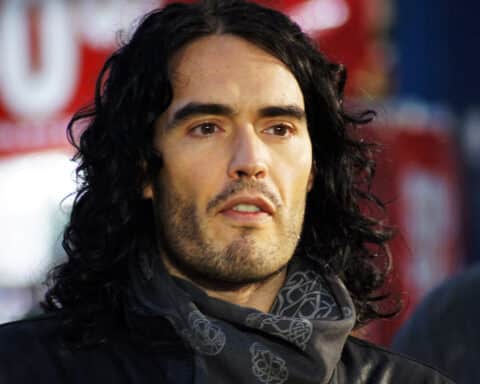Because of the enormous stockpiles of nuclear bombs, “people are living in the grip of constant fear,” wrote Pope St. John XXIII in his 1963 encyclical Pacem in Terris. “They are afraid that at any moment the impending storm may break upon them with horrific violence.” Therefore, “nuclear weapons must be banned,” the pope emphatically declared. “A general agreement must be reached on a suitable disarmament program, with an effective system of mutual control.”
As portrayed in Christopher Nolan’s new film, “Oppenheimer,” J. Robert Oppenheimer, director of the program that developed and assembled the only two nuclear weapons ever used in war, was an erstwhile if ambiguous ally of the pope.
A dizzying pace
It was the purpose of neither the film nor Kai Bird and Martin J. Sherwin’s 2005 biography on which it is based — “American Prometheus: The Triumph and Tragedy of J. Robert Oppenheimer” — merely to account for the life of the brilliant American physicist who led the development of the atomic bomb. Rather, both the authors and the director intended to use the complex and contradictory character of the man as a metaphor for the complicated and conflicting history of the creation of the bomb and its continuing presence in our lives. In their respective ways, both the book and the film are stunning successes.
Like the book, the film opens with a scene from the hearing on Oppenheimer’s 1954 appeal from the revocation of his national security clearance by the U.S. Atomic Energy Commission (“AEC”). The appeal was rigged by Oppenheimer’s champion-turned-nemesis, Lewis Strauss, the self-important chairman of the AEC, to assure that the security clearance was denied. But while the book sets the scene by beginning with the inquest, it proceeds along a chronological account of Oppenheimer’s life in the form of traditional narrative historical biography. And while the development of the atomic bomb is, of course, central to the story, the subject of the book is J. Robert Oppenheimer, from his childhood to his death, and including many biographical relationships and details that are omitted from the film.
The film, on the other hand, stands in stark contrast to these two characteristics. While, of course, Oppenheimer (wonderfully portrayed by Irish actor Cillian Murphy) is central, the subject of the film is the atomic bomb. And rather than to follow a historical chronology, the film lurches between different periods of Oppenheimer’s life and career at a frenetic — sometimes dizzying — pace. Eschewing sequential prose, Nolan opts for feverish poetry. As an artistic interpretation of the biography, the film’s many rapid cuts between short vignettes convey the hasty and disorienting development of the Manhattan Project while attempting to tell a coherent and intelligible story. Whether or not Nolan succeeds in the latter is up to the judgment of someone who sees the film without having read the book. I certainly had a much easier time piecing together the patchwork film having read the biography beforehand.
Morality, or immorality
This is not, however, a criticism of the film. On the contrary, if it was Nolan’s purpose to illustrate the pressure, stress and anxiety that accompanied the development and use of the bomb through the chaos, contradiction and ambiguity of Oppenheimer’s adult life and scientific career, he is highly successful. Though clocking in at just under three hours, the film never lets you pause to ponder the moral implications of the bomb. Instead, it forces you to keep up with the frenzied race to create the ability to kill tens of thousands of people with one “gadget” (as Oppenheimer insisted on calling it) while trying to take account of the dread moral implications on the fly. Even as the staff at Los Alamos builds into a crescendo of frenzied applause and stomping of feet after the “successful” bombing of Hiroshima, Oppenheimer veers between patriotic jingoes and vertiginous hallucinations of the horror he has wrought. On the one hand, he defended the development of the bomb against some of his own scientist’s growing moral apprehension; on the other hand, he became the world’s most prominent representative of that unease.
Adding to the equation adultery, international politics, the “red scare” of 1950s McCarthyism, and the personal animosity of Strauss (played by Robert Downey, Jr.) renders the film a highly suspenseful mélange. As Robert Oppenheimer tries to steer through the weight of accountability for his role in the development of the bomb, his personal moral failure, and Strauss’s fanatical vengeance for a petty insult, we feel the stress of Oppy’s own fragility. Oppenheimer, the “father” of the A-bomb, became the most important voice for curtailing its development and prohibiting its use. And his opposition to the hydrogen bomb elicited not only political opposition but personal betrayal that Oppenheimer’s longsuffering wife, Kitty, could never forgive.
A recurring consideration in the film is an equation by Edward Teller that suggested the possibility that detonating a nuclear fission bomb (the kind dropped over Hiroshima and Nagasaki) could ignite a chain reaction in the atmosphere. As the film draws to a close, Oppenheimer reminds Albert Einstein of that equation raising the possibility that by creating the bomb, we could destroy the world. “I believe we did,” says Oppenheimer. If, as Pope John XXIII suggests, “true and lasting peace among nations cannot consist in the possession of an equal supply of armaments but only in mutual trust,” in some sense, he was probably correct. “Oppenheimer” accounts for this sense in a morally challenging, artistic masterpiece of filmmaking.





